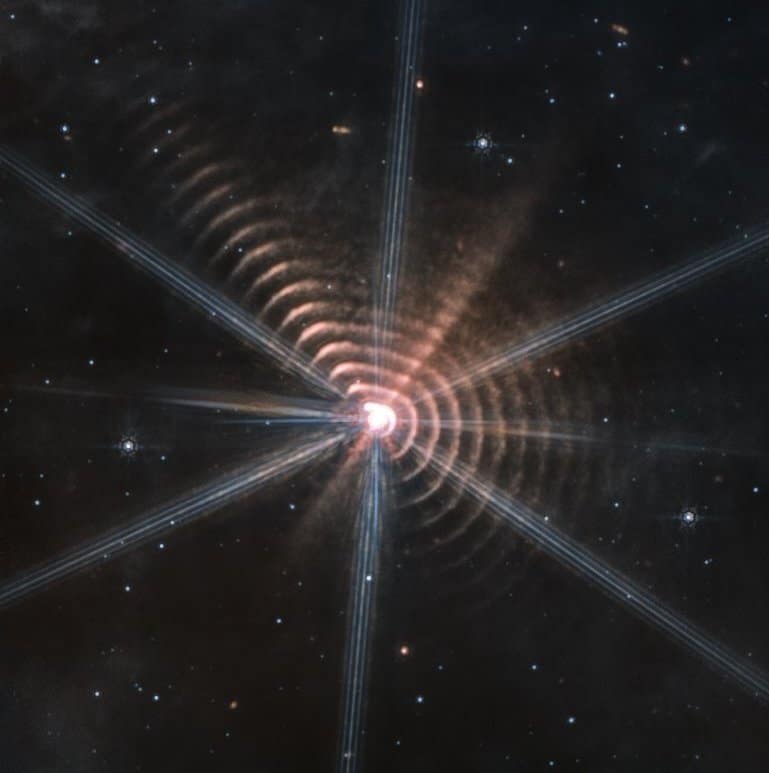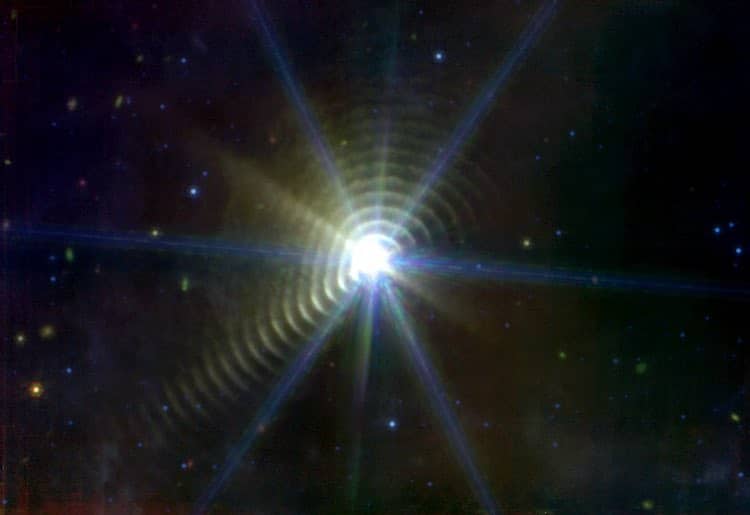JWST Captures Square-Shaped Ripple Rings Around a Star, Perplexing Astronomers

Credit: NASA/ESA/CSA/Ryan Lau/JWST ERS Team/Judy Schmidt
“Nope, I don’t know what this is…” admitted citizen scientist Judy Schmidt when she shared a perplexing image on Twitter of a start with square-shaped ripple rings. Schmidt works with unprocessed scientific data from the James Webb Space Telescope (JWST) that has not been presented publicly to create incredible images. This glimpse of the star WR 140 is especially interesting.
The Mid-Infrared (MIRI) sensor on JWST reveals squarish, equidistant ripples surrounding the star, something European Space Agency science advisor Mark McCaughrean describes as “bonkers.” Schmidt’s Twitter thread is full of people sharing theories to explain the phenomenon, from a fingerprint being on the lens to it being proof that aliens are out there. McCaughrean assures, though, that the “red curvy-yet-boxy stuff is real, a series of shells around WR 140. Actually in space. Around a star.” And as McCaughrean points out in his Twitter thread, WR 140’s Wikipedia page features a similar image from fellow volunteer Melina Thévenot, highlighting that this is not user error.
WR 140 is a Wolf-Rayet star, a massive and evolved star. The National Institutes of Natural Sciences explains that this type of star “has already lost [its] hydrogen-rich envelope,” and its surface is full of heavy elements, like carbon, that are created from its internal burning of helium. While other evolved stars expel lightweight hydrogen-rich materials, Wolf-Rayet stars expel all of those heavy elements, creating a large amount of dust.
McCaughrean explains that this dust surrounding WR 140 is “being sculpted by dynamical interactions with another star orbiting around it.” However, with other Wolf-Rayet stars, this sculpting ends up creating spirals. The scientist says coming up with an explanation for the geometry of WR 140’s shells “isn’t immediately obvious” to him. Thankfully, Ryan Lau, a NOIRlab astronomer and the collector of this exciting dataset, has some promising news to all of us wondering: “Yes, those nested ‘squircular’ rings are real. Our paper on this has been submitted so please stay tuned for the full story.”
Scroll down to see more about this glimpse into the vast universe out there.
Citizen scientist Judy Schmidt amazed many when she shared a perplexing image she created using data from the James Webb Space Telescope.
Nope, I don't know what this is. Some kind of spiral nebula around WR140. I'm sure we'll find out more later.
h/t to @yuvharpaz & @JWSTPhotoBot pic.twitter.com/ukenoIXrnj
— Judy Schmidt (@SpaceGeck) August 29, 2022
People were quick to reply with their own theories to explain the curious squarish ripples that surround the star WR 140.
I thought there was a fingerprint on the lens…
— Phin Pope (@phinp) August 29, 2022
Could it be pulses and ring effect is light delays (getting to telescope)?
— ECMayo (@MayoSoft) September 3, 2022
European Space Agency science advisor Mark McCaughrean stepped in to quell the deniers, though.
Well that’s bonkers 😬
The six-pointed blue structure is an artefact due to optical diffraction from the bright star WR140 in this #JWST MIRI image.
But red curvy-yet-boxy stuff is real, a series of shells around WR140.
Actually in space. Around a star.
HT @spacegeck 👍 https://t.co/6TLjfErL37
— Mark McCaughrean (@markmccaughrean) August 29, 2022
Schmidt is not the only one to have captured this phenomenon; another volunteer created this image of WR 140 that is featured on Wikipedia, highlighting that this is not user error.

Image Credit: NASA, ESA, CSA JWST MIRI, Melina Thévenot & Ryan Lau et al.
He went on to explain that WR 140 is a Wolf-Rayet star, a massive and evolved star that expels mass amounts of heavy elements, like carbon, creating a lot of dust. WR 140’s dust is being shaped into those ripples by another star orbiting around it. One user shared a visualization of this.
This was really helpful for me pic.twitter.com/3JpbS1tlVN
— Jonathan Byrd (@jonathanbyrd) August 31, 2022
McCaughrean did admit, though, that he is still perplexed as to why the dust has formed into squarish ripples, instead of the usual spiral shape that is created around other Wolf-Rayet stars.
Exactly what the geometry is in WR140, with the curved & yet boxy shells, isn’t immediately obvious to me & why there are discrete, separated shells rather than a spiral structure … well, I’m sure Ryan & his colleagues are working on that right now 🙂
— Mark McCaughrean (@markmccaughrean) August 29, 2022
Ryan Lau, NOIRlab astronomer and the collector of this incredible dataset, stepped in to reaffirm the ripples are real and there will be more to explain them in the near future.
Hi Mark, All — it's great to see all of the excitement on this. Yes, those nested “squircular” rings are real. Our paper on this has been submitted so please stay tuned for the full story.
— Ryan Lau (@RyanLauAstro) August 29, 2022
h/t: [Intelligent Living]
Related Articles:
Astronomers Discover an Ocean-Covered “Super-Earth” Exoplanet
JWST Captures Possibly the Most Perfect Einstein Ring Galaxy Ever Seen
James Webb Space Telescope Captures Spectacular Auroras on Jupiter
Spectacular ‘Cartwheel Galaxy’ Captured by James Webb Space Telescope
READ: JWST Captures Square-Shaped Ripple Rings Around a Star, Perplexing Astronomers

0 Commentaires